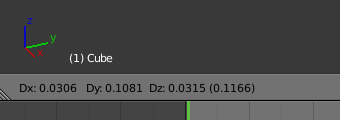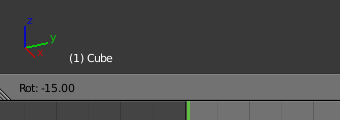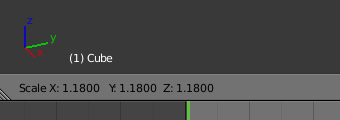Basic Transformations¶
Grab/Move¶
Reference
GIn Object Mode, the grab/move option lets you translate (move) objects. Translation means changing location of objects. It also lets you translate any elements that make up the object within the 3D space of the active 3D View.
Grab/Move works similarly here as it does in the Node Editor, Graph Editor, UV/Image Editor, Sequencer, etc.
Pressing G activates “Grab/Move” transformation mode.
The selected object or element then moves freely according to the mouse pointer’s location and camera.
You can also move an object by clicking and holding RMB on the object to move it.
To confirm the action, press LMB.
While Grab/Move is active, the amount of change in the X, Y, and Z coordinates is displayed at the bottom left corner of the 3D View editor.

Translation Display.
Tip
Moving an object in Object Mode changes the object’s origin. Moving the object’s vertices/edges/faces in Edit Mode does not change the object’s origin.
Rotate¶
Reference
RRotation is also known as a spin, twist, orbit, pivot, revolve, or roll and involves changing the orientation of elements (vertices, edge, face, Object etc) around one or more axes or the Pivot Point.
The angle of rotation will be displayed in the footer of the 3D View editor.

Rotation values.
Trackball Rotation¶
A free rotation mode. Press R, R to enable Trackball rotation.
Scale¶
Reference
SScaling means changing proportions of objects.
Pressing S will enter the Scale transformation mode where the
selected element is scaled inward or outward according to the mouse pointer’s location. The
element’s scale will increase as the mouse pointer is moved away from the Pivot Point and
decrease as the pointer is moved towards it. If the mouse pointer crosses from the original side of the
Pivot Point to the opposite side,
the scale will continue in the negative direction and flip the element.

Basic scale usage. From left to right, the panels show: the original Object, a scaled down Object, a scaled up Object and a scale-flipped Object.
The amount of scaling will be displayed in the footer of the 3D View editor.

Scale values.
Common Options¶
There are multiple ways to transform an element which include:
- The keyboard shortcut.
- The menu in the header or the Transform panel in the Tool Shelf.
- The 3D Transform Manipulator widget.
- The Transform panel in the Properties region or the Object tab.
Confirm and Cancel¶
LMB click to accept changes.
This behavior can be changed globally by activating Release Confirms
in the User Preferences,
so that a single RMB drag can be used to move and confirm.
To cancel the transformation press RMB or Esc instead.
This will reset the object or element to its original state.
See also
Using combination of shortcuts gives you more control over your transformation. See Transform Control.
Operator Panel¶
In the case of the 3D View, there is the possibility to tweak the operation once accepted, using the specific Operator panel corresponding to the tool.
- Value
The amount of the transformation.
Vector, Angle
- Constrain Axis
Used to constraint the transformation to one or more axes.
X, Y, Z
- Orientation
- Shows the Orientations of the constraint axes.
- Proportional Editing, Falloff, Size
- Activates/deactivates Proportional Editing and configures the type Falloff and Size of the Proportional Edit tool.
- Edit Grease Pencil
- ToDo.
- Edit Texture Space
- This checkbox lets you apply the transformation on the Texture Space, instead of the object or element itself. Only available in translation and scale.
- Confirm on Release
- Shows if either the operation was drag-and-release or move-and-confirm.
Texture Space¶
Reference
Shift-T, Shift-Alt-TTransforms the object Texture Space, which will become visible in the 3D View. Same as if the Edit Texture Space checkbox is enabled.
- Move Texture Space
Shift-T - Scale Texture Space
Shift-Alt-T